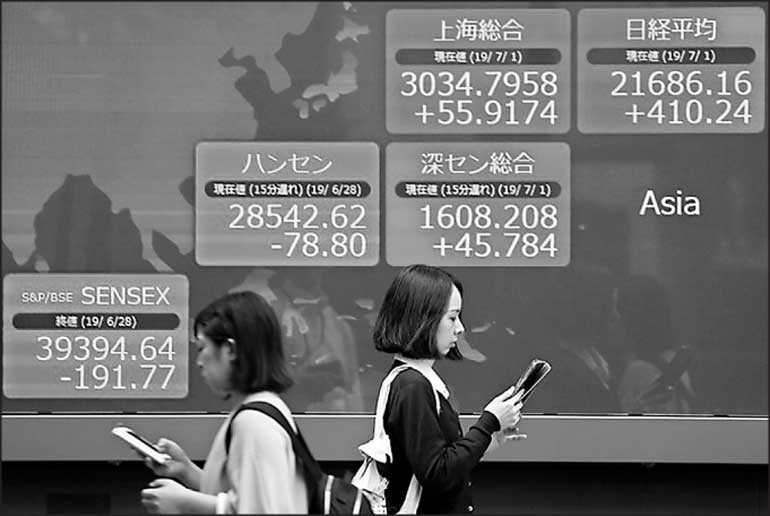Monday Apr 21, 2025
Monday Apr 21, 2025
Saturday, 13 July 2019 00:08 - - {{hitsCtrl.values.hits}}

LONDON (Reuters): World shares came within a whisker of posting their first weekly loss since May on Friday and the dollar was down for a third day running, as even a stronger-than-expected U.S. inflation print failed to shake bets on Federal Reserve interest rate cuts.
European shares ticked higher in early trade after a run of modest falls this week and as investors also digested an end of week blizzard of Chinese data from Asia.
China’s yuan-denominated exports rose 6.1% in the first half of this year from a year earlier, while imports increased 1.4%. On top of that its trade surplus with the United States, a major source of friction with its biggest trading partner, rose to $29.92 billion in June from $26.9 billion in May.
The data comes after a string of disappointing economic reports from around the globe, which showed that the global economy suffered from a protracted U.S.-China trade war that forced major central banks to take a more accommodative stance.
China is also due to release second-quarter GDP figures on Monday which are expected to show the world’s second-largest economy slowing to its weakest pace in at least 27 years.
Industrial production figures for the euro zone are due, and could be an important trigger for the European Central Bank to move further along an easing path, with economists split on whether the numbers will reveal any meaningful signs of recovery.
“Euro area industrial production is expected to expand by 0.9% month-on-month in May according to the country level releases we have to hand so far,” RBC analysts said in a note.
This would mark the best monthly expansion in euro area industrial production since January, they added, though it will still represent a significant contraction from May 2018.
There was broad divergence in the estimates retrieved by Reuters, with the most optimistic eyeing a 0.9% monthly rise and the most pessimistic seeing a fall of 0.5% - the same outcome as in April.
European Central Bank policymakers gathering last month agreed on the need to be ready to provide more stimulus to the euro zone economy in an environment of “heightened uncertainty”, official minutes of the meeting showed on Thursday. In Asia, MSCI’s broadest index of Asia-Pacific shares outside Japan was down 0.1%.
Against a basket of currencies, the dollar was lower for a third straight day, down 0.1%. A stronger-than-expected reading of failed to shake convictions that the Federal Reserve will start cutting interest rates at a policy meeting later this month.
The core U.S. consumer price index, excluding food and energy, rose 0.3% in June, the largest increase since January 2018, data on Thursday showed.
The reading pushed U.S. Treasury yields higher, but money markets still indicated one rate cut at the end of July and a cumulative 64 basis points in cuts by the end of 2019.
Comments by Chicago Fed President Charles Evans scheduled later on Friday and New York Fed President John Williams on Monday will provide a chance to gauge how dovish the central bank is, said Masafumi Yamamoto, chief forex strategist at Mizuho Securities.
“If these Fed officials are not as dovish as Powell, and if the New York Fed’s manufacturing survey on Monday proves stronger than forecast, they could show that the dollar weakening in response to Powell’s congressional testimony was overdone.”
Elsewhere in currencies, the euro got a boost from a selloff in the German bond market, rising 0.1% to $1.1270.
Safe haven German government bonds were set for their biggest weekly selloff in nearly one-and-a-half years as signs of economic strength in the United States and parts of Europe suggested fears of a downturn may be overdone.
Oil prices hovered near six-week highs and were on track for a weekly gain as U.S. oil producers in the Gulf of Mexico cut more than half their output because of a tropical storm and as tensions continued to simmer in the Middle East.
Global benchmark Brent crude LCOc1 gained 0.77% to $67.03 per barrel. U.S. West Texas Intermediate (WTI) crude was up 0.68% to $60.57 a barrel.
Gold prices, dulled by the stronger-than-expected U.S. consumer inflation data, regained their shine thanks to renewed trade worries and rate cut expectations. Spot gold last traded up 0.5% at $1,410.99 per ounce.